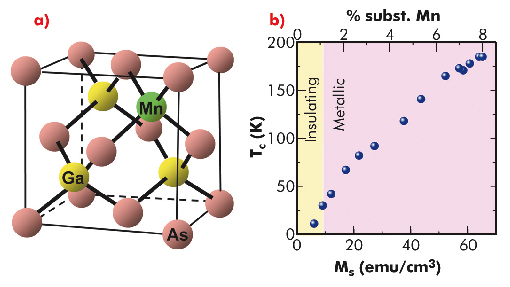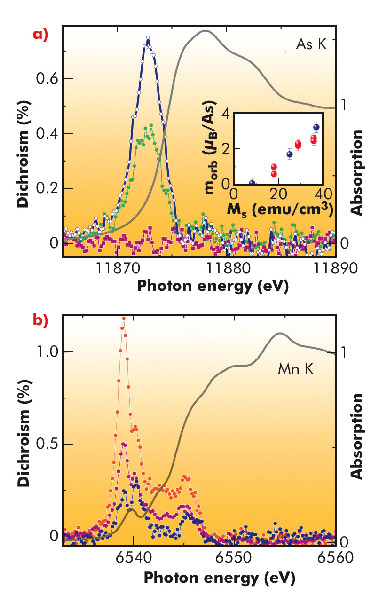- Home
- Users & Science
- Scientific Documentation
- ESRF Highlights
- ESRF Highlights 2010
- Electronic structure and magnetism
- Element-specific magnetism across the metal-insulator transition in (Ga,Mn)As
Element-specific magnetism across the metal-insulator transition in (Ga,Mn)As
Substitution of Mn into the semiconductor GaAs leads to some remarkable and closely correlated effects on its electrical and magnetic properties (Figure 78). At Mn concentrations above around 1%, ferromagnetic ordering takes place below a critical temperature TC, while a transition from insulating to metallic conductivity occurs at around 2% Mn doping. The important role of charge carriers in coupling together the spins of distant Mn ions has been highlighted in experiments showing a control of TC using electric fields [1]. This potentially offers new applications at the interface between microelectronics and spintronics. However, the occurrence of magnetic order on both sides of the metal-insulator transition is a long-standing puzzle and a subject of considerable recent debate. The detailed origins of the transition and accompanying stepwise changes in electronic and magnetic properties are poorly understood.
To address this issue, we performed an X-ray magnetic circular dichroism (XMCD) study at beamline ID12 on a series of (Ga,Mn)As and (In,Ga,Mn)As thin films with varying Mn concentration spanning the metal-insulator transition. By probing the XMCD at both the Mn and As K absorption edges, we were able to obtain element-specific information on the electronic and magnetic properties. Furthermore, features in the spectrum associated with states in the vicinity of the Fermi level were found to be strongly sensitive to the Mn concentration, offering a microscopic insight into the relationship between conductivity and magnetism in this material.
The key results are shown in Figure 79, where the As and Mn K edge absorption and XMCD spectra are plotted for samples on either side of the metal-insulator transition. The As XMCD manifests itself as a sharp peak that barely coincides with the onset of the absorption edge. The presence of an XMCD signal at lower energy than the absorption edge is an indicator of a density of unoccupied As 4p states near the valence band edge, with a net orbital magnetic moment. The As XMCD increases with the Mn concentration, and a sum rule analysis reveals a linear relationship between the As 4p orbital magnetic moment and the magnetisation MS measured by bulk magnetometry (Figure 79a, inset). However, at a value of MS that coincides approximately with the onset of the metal-insulator transition, the As 4p moment falls to zero.
 |
|
Fig. 78: a) Mn incorporated in the zincblende GaAs structure. b) Ferromagnetic transition temperature TC versus concentration of magnetic moments. |
Different behaviour is observed at the Mn K edge (Figure 79b). The Mn XMCD spectrum consists of at least three distinct peaks, the largest of which are centred at a pre-edge peak in the absorption spectrum. The lowest energy peak in the XMCD spectrum shows a sharp decrease on crossing the metal-insulator transition. We ascribe this peak to transitions from the Mn 1s core level to p-d hybridised states lying just above the Fermi level. The reduced Mn XMCD in the metallic regime, combined with the emergence of an As 4p orbital polarisation, is a direct indication that the character of the states close to the Fermi level (i.e., the states involved in conduction) changes from Mn-like to As-like.
 |
|
Fig. 79: a) As K edge absorption spectrum (grey curve) and XMCD spectra for films with effective Mn concentrations 4.5% (blue), 3.2% (green), 1.1% (pink). Inset: As 4p orbital magnetic moment versus magnetic moment concentration MS. b) Mn K edge absorption spectrum (grey curve) and XMCD spectra for films with effective Mn concentrations 4.5% (blue), 1.1% (pink), 0.6% (orange). |
To conclude, our results point to a qualitative change in the character of states near the Fermi level on going from the low-doped insulating state to the high-doped metallic state. Therefore, the K edge XMCD spectra provide a signature of the localisation of charge carriers in (Ga,Mn)As and related compounds, potentially offering a new insight into the nature of the metal-insulator transition in dilute magnetic systems.
Principal publication and authors
P. Wadley (a), A.A. Freeman (a,b), K.W. Edmonds (a), G. van der Laan (b), J.S. Chauhan (a), R.P. Campion (a), A.W. Rushforth (a), B.L. Gallagher (a), C.T. Foxon (a), F. Wilhelm (c), A.G. Smekhova (c) and A. Rogalev (c), Phys. Rev. B 81, 235208 (2010).
(a) School of Physics and Astronomy, University of Nottingham (UK)
(b) Diamond Light Source (UK)
(c) ESRF
References
[1] I. Stolichnov, S.W.E. Riester, H.J. Trodahl, N. Setter, A.W. Rushforth, K.W. Edmonds, R.P. Campion, B.L. Gallagher, C.T. Foxon and T. Jungwirth, Nature Mater. 7, 464 (2008).



